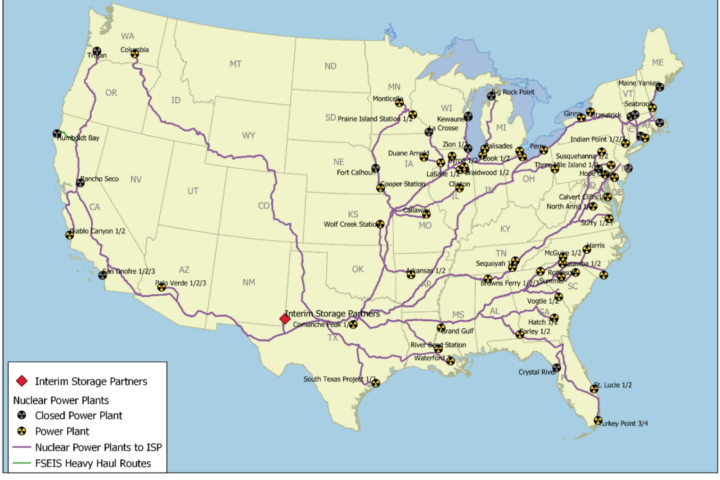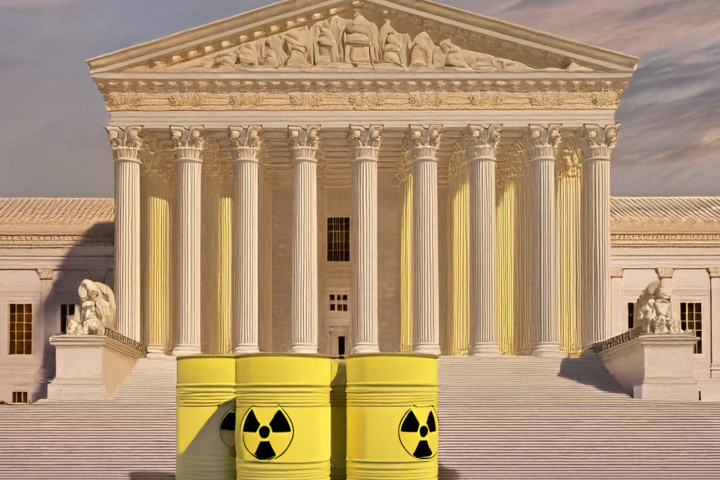Let’s start with what we know.
The Waste Isolation Pilot Plant (WIPP) is the Nation’s only operating geologic repository for nuclear waste. WIPP can legally only accept a very specific type of waste – transuranic (TRU) waste generated at defense-related nuclear facilities. “Transuranic” refers to atoms of man-made elements that are heavier (higher in atomic number) than uranium. The most prominent element in most TRU waste is plutonium. Some TRU waste consists of items such as soil, rags, tools, and laboratory equipment contaminated with radioactive materials. Other forms of TRU waste include organic and inorganic residues or even entire enclosed contaminated cases in which radioactive materials were handled.
The WIPP underground is 2150 feet below the surface. And will consist of 8 separate panels with 7 football field-sized rooms per panel. (Two additional panels, 9 & 10, are to be placed in the existing tunnels that lead to Panels 1 – 8.) WIPP has a legal maximum capacity of 175,564 m3 and is currently starting to fill Panel 7.
Timeline –
At 12:25 p.m. February 5, 2014, – Shortly after 11 a.m., an underground vehicle used to transport salt is on fire in the underground.
At 11:30 PM Friday February 14, 2014, a continuous air monitor detected airborne radiation in the underground.
Sometime on Saturday February 15, 2014, a filter aboveground at the fence line of the WIPP facility (Location A) was sampled. The field preliminary analysis showed .87 Bq. (EPA’s action level for the isotopes of concern is 37 Bq.)
Sometime on February 17 & 18, 2014, more samples were taken from other monitors and also from Location A, which showed a much lower reading (.04 Bq) than it did three days earlier. http://www.wipp.energy.gov/Special/WIPP%20Environmental%20Sampling%20Results.pdf
Are the fire and the release related?
On the surface I would have to say yes. The first large fire in the underground was followed by first release 9 days later. But the 9 days is a problem. Apparently nothing happened for 9 days after the fire then something happened to cause the release of radionuclides aboveground. Did the fire somehow loosen the ceiling 2000’ away? Maybe, but right now, I have to think that it is a freak coincidence, because we don’t know the cause of the release.
Is the release serious?
Yes, WIPP is not supposed to leak for 10,000 years.
Is the release a threat?
Elevated levels of radionuclides can always pose a threat. The primary threat of alpha-emitters like plutonium is inhalation. Inhalation of very small amounts of plutonium can cause cancer.
The Location A monitor was some 6750 feet from the assumed source of the release, Panel 7. (2000’ from Panel 7 to the bottom of the exhaust shafts + 2150’ to the surface + ½ mile (2600’) to the monitor) Did Location A pick up a representative sample of the release? Unlikely. There are too many variables to know if the Feb 15 sample from Location A was higher or lower than the main part of the release. But the results do show that any higher risk is more than likely localized.
The map shows the seven monitoring locations. I have always thought that this was not enough monitoring locations.
What about the plume maps floating around the internet?
One in particular is getting some attention.
Please remember that these maps represent one possible outcome of a group of inputs entered into a NOAA computer program. We don’t know the input parameters that were used, therefore we do not know what this map is based on. This is not an actual map of where any actual plutonium actually went.
Also please notice the units.
The yellow is “1.0E-13 mass/m3”.
That would be .000,000,000,000,1 of something per cubic meter.
The blue is “1.0E-16 mass/m3”
That would be .000,000,000,000,000,1 of something per cubic meter.
It’s not nothing, but it’s not much. I would like to see what this map is based upon. This does show how well computers can crunch numbers.
What about claims of nuclear salt water rocket explosions in the WIPP underground?
There is a website in Hungary. That has an alert –
A grim “Of Special Importance” (highest classification level) report prepared by the Russian State Atomic Energy Corporation (ROSATOM) circulating in the Kremlin warned that the “potentially catastrophic nuclear event” currently unfolding at the US atomic Waste Isolation Pilot Plant (WIPP) near Carlsbad, New Mexico has prompted the White House to begin pre-staging government forces and equipment in the event a large-scale evacuation is needed, Whatdoesitmean.com reported.
I’m sorry, but I don’t have time to respond to Whatdoesitmean.com. There was no Rosatom/WIPP report. There are no nuclear salt-water rockets in the underground at WIPP, exploded or otherwise.
What to do?
In the short term let’s keep a critical ear open to the DOE story and separate out the spin. I’m waiting for the next batch of samples to be released to the public. WIPP has several proposals modify its permit in the works. Clearly, at this time, those all need to be put on hold until details of the exact cause of this accident are released to the public. The health and environmental impacts must be fully known and cleanup must be completed to everyone’s satisfaction.


